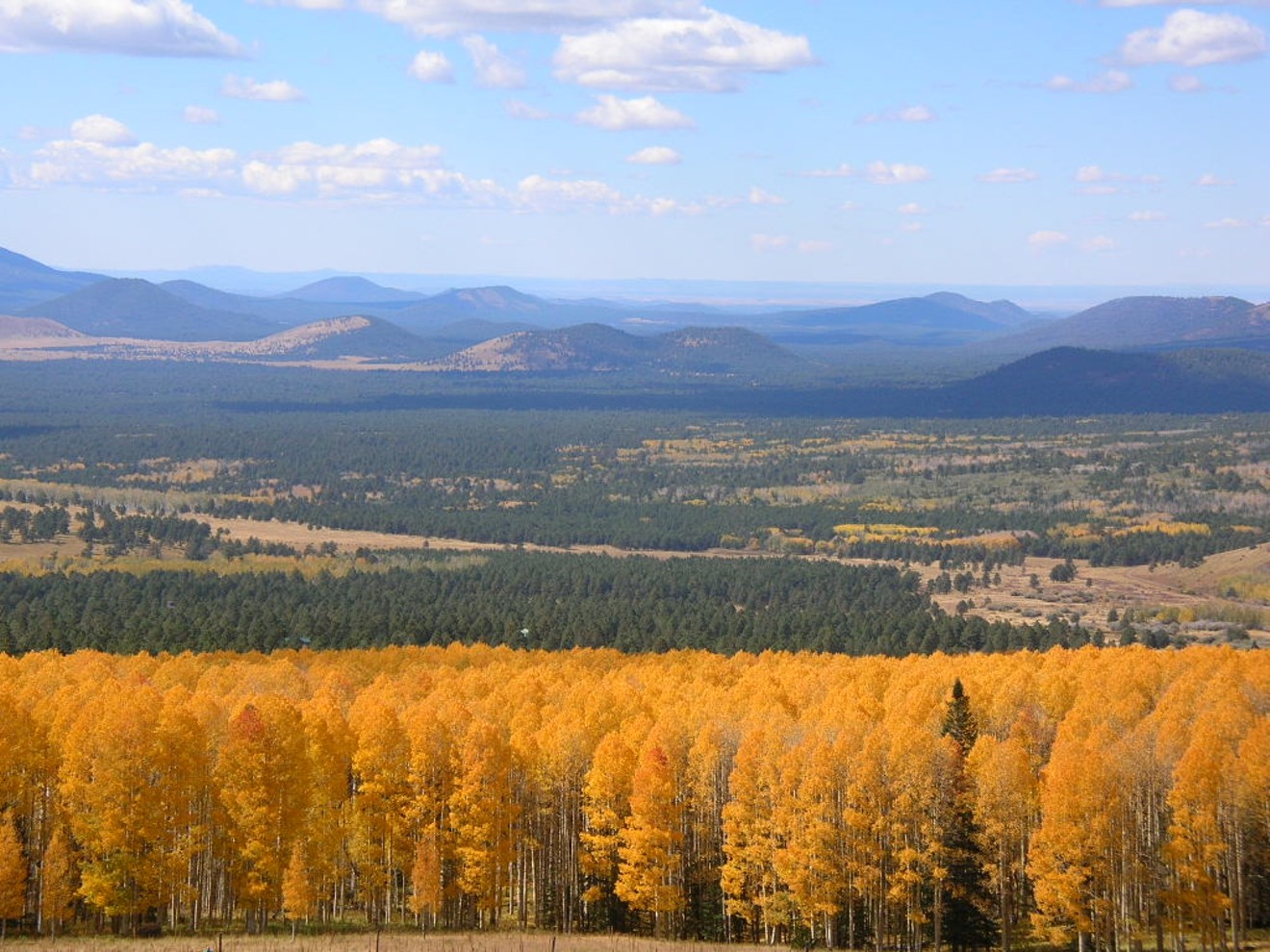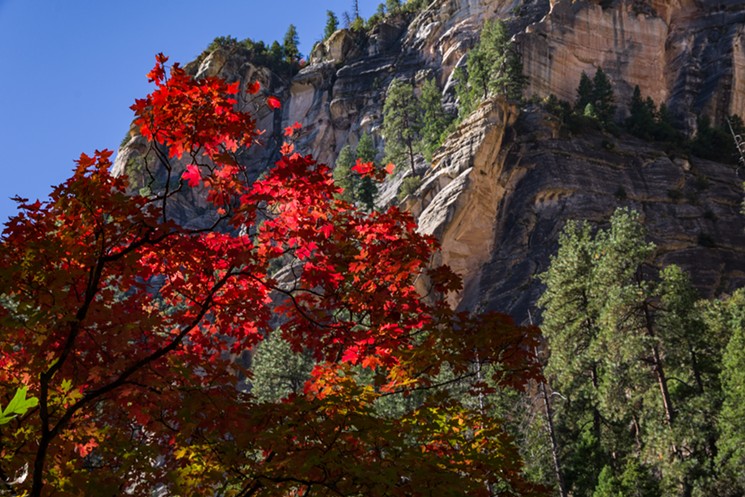The East Coast calls them "leafers" — some with affection, some without.
They're the tourists who travel to see the most ubiquitous fall icon: colored leaves. Those reds, yellows, and oranges are a preparation for winter as the green chlorophyll disappears from the leaves. Snowbirds and transplant residents will remember color-changing well, but native Phoenicians have a different, sometimes absent, fall experience.
While our cousins to the north and south of the state often enjoy a distinctly four-seasoned year, residents of the metropolitan area are stuck with two slightly different periods, characterized by hot and, well, not — green leaves and dead leaves, essentially. Not so in the areas around us, where aspens turn yellow and maples become a variety of yellow, orange, and red (or a combination of all three). Oaks get a touch of yellow, orange, or brown, while cottonwoods take on a yellow hue – as do elms, ash, and willows.
Luckily, "leaf peeping" is still a pleasure plenty of Phoenicians can partake in, requiring nothing more than a full tank of gas and a few spare hours. Here are five easy-to-drive day trips that provide many opportunities to see the leaves — and snap a shot.
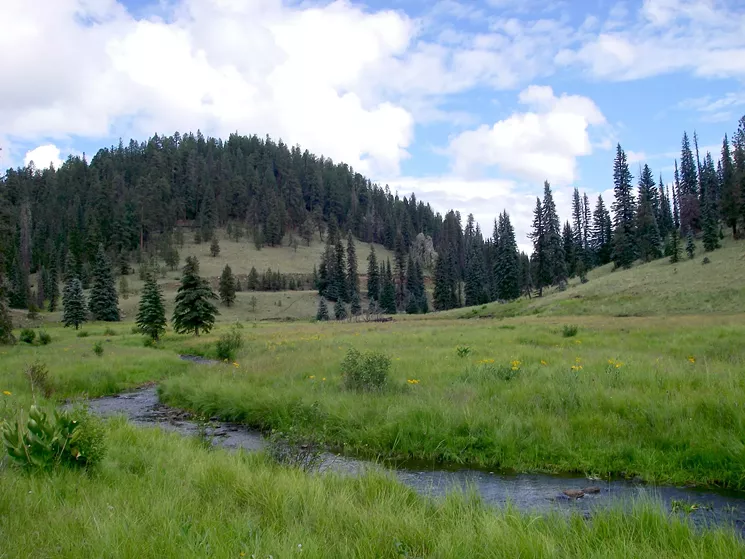
Thompson Trail in the White Mountains in Arizona.
Al_HikesAZ/CC BY-NC 2.0 via Flickr
White Mountains
The White Mountains in eastern Arizona offer one of the earliest glimpses of color in the state due to their elevation of 11,000 feet. Leafing is best during early October (generally the first three weeks), and while the area is known for plenty of pine and fir trees, it is speckled with a healthy dose of Gambel oaks, which turn a gorgeous yellow-orange, and aspens which offer bright greens that turn into brilliant yellows.
The Show Low, Pinetop-Lakeside, and Greer communities are among those around the range with their own beautiful forest drives, and Greens Peak off Forest Road 117 north of State Route 260, between Sunrise Park Resort and the town of Greer, offers a bird's-eye view of the expanse of trees below. Blue Vista Viewpoint and the areas around Alpine and Big Lake are also great lookouts; the latter is off State Route 273 south of Eagar, though the area is still mildly recovering from the Wallow Fire of 2011 – still the biggest fire in recorded Arizona history.
Depending on stops and ultimate destinations, the drive east can take anywhere from four hours to five and a half. Go to the Arizona White Mountains website for information on the range and its surrounding communities.
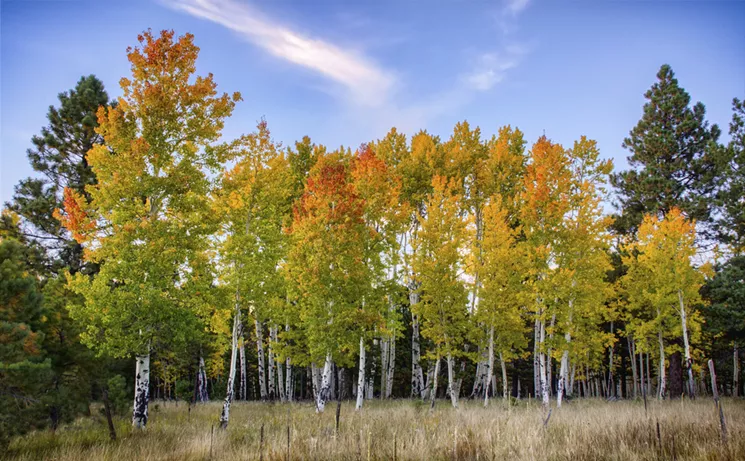
A stand of aspen trees in Hart Prairie, Flagstaff.
Michael WIlson/CC BY-NC-ND 2.0 via Flickr
Flagstaff
Thanks to the Coconino National Forest, Flagstaff is probably the state's biggest leafer draw. For those without lead feet, it's about a 90-minute to two-hour straight shot up Interstate 17 North and offers a variety of places to capture fall color, from late September through November when snowfall starts.
Hart Prairie Road is a winding drive along Forest Service Road 151. Take U.S. 180, Flagstaff's main drag, 10 miles north to connect to 151. The loop drops you off almost right back where you started after a cruise through fall foliage. Near the base of Arizona Snowbowl is a similar, 1.8-mile hike (the Aspen Nature Loop), offering an easy workout and view of the San Francisco Peaks and Kendrick Mountain, which are home to plenty of – you guessed it – aspens.
The Weatherford Trail, Abineau and Bear Jaw Loop, and Lockett Meadow are all great places to view and explore the changing color among the aspen groves. Luckily, the city has no shortage of them, and with a snowy-capped backdrop like Humphreys Peak, it's a great location to have your camera at the ready.
Visit the Flagstaff CVB website or the Greater Flagstaff Chamber of Commerce website for other ideas and details on routes and closures.
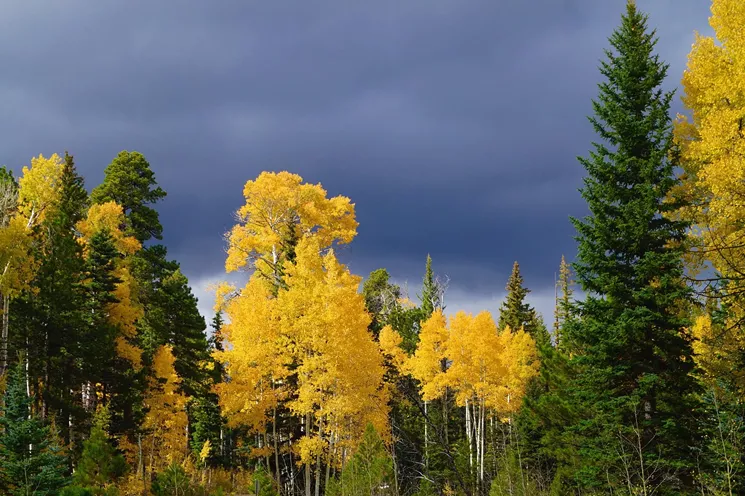
Fall foliage on the Grand Canyon's North Rim
Broderick Delaney/CC BY 2.0 via Flickr
North Rim, Grand Canyon
We would be remiss not to mention one of the natural wonders of the world in a list of must-see places. The Grand Canyon is home to much of the state's aspen population within the Kaibab National Forest, and it's pretty hard to take a bad picture surrounded by the sheer rock walls of the canyon and Colorado River below. The Kaibab Plateau is arguably the best place to catch a wide view of all the golden leaves, but the drives up to the canyon, following smaller, forest route roads, offer a feeling of being totally encapsulated by the leaves.
For those willing to turn their day trips into an overnight (or a really, really long day) the North Rim of the Grand Canyon is one of the state's best bets when it comes to fall color. From Phoenix, head north up the I-17 toward Flagstaff; from there, take Highway 89 north to Bitter Springs, then follow Highway 89 Alt. West to Jacob Lake. Highway 67 South from Jacob Lake leads right to the North Rim. It's a good five- to six-hour car ride, but the North Rim is far less populated than its southern sister and hosts just as many breathtaking views.
The North Rim experiences a shorter season than the South; the park is now only open for day use, and according to the website, visitors "should plan to be self-sufficient and bring enough food and water for the day. Limited services will be available." The park will remain open through November 30 or the first major snowstorm, whichever comes first. For more information and updated road or canyon conditions, go to the Grand Canyon National Park website or call 928-638-7888.
Oak Creek Canyon
The river gorge is a perfect place to escape year-round, and is equally as appealing for leafers from October through November. As the temperatures drop, the leaves do the same, but unlike other locations in the West that feature yellowed aspen leaves, Oak Creek is home to the maples and oaks normally associated with the East Coast.
One of the more popular destinations along the Mogollon Rim nestled between Sedona and Flagstaff, the area is a two-hour drive to the north. Walk along the West Fork Trail (the most popular trail in the entire Coconino National Forest), surrounded by deep-red color, or drive the canyon's length to cover more ground. Though the area lost foliage during 2014's Slide Fire, which burned a devastating 21,227 acres, there are plenty of reddish-gold hues flooding the space – with a uniquely Southwestern take. After all, you can't see red leaves and red rocks in Vermont.
For accurate day-to-day information and routinely updated route and weather conditions, head to the Sedona Guide website.
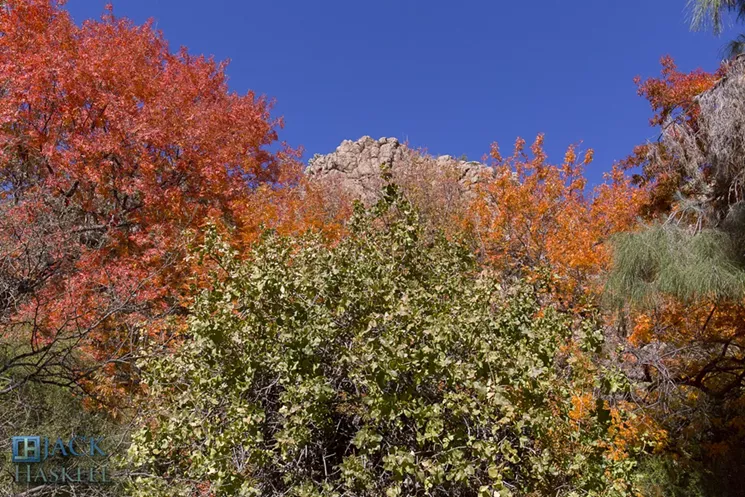
Fall colors at the Boyce Thompson Arboretum.
John Haskell/CCY BY 2.0 via Flickr
Boyce Thompson Arboretum State Park
Conveniently situated an hour east of Phoenix, the Boyce Thompson Arboretum State Park outside of Superior is a great bet for late bloomers. Peak color-spotting varies due to weather and climate conditions, but a good bet is during the time that the park would typically hold its its annual Arizona's Fall Foliage Finale during mid- to late-November (it's not happening this year due to COVID). Leaves from honey locust, pomegranate, and soapberry trees offer light yellow to deep copper and golden tones before they shed, while the Arizona sycamore tends to reach a yellow-red, the cottonwood a bright yellow, and the walnuts can reach a dark red.
Boasting 323 acres, the arboretum is the state's largest and oldest botanical garden, and features more than 3,000 types of plants – so there's certainly something to see. Located just off Highway 60, the arboretum is open daily from 8 a.m. to 5 p.m. from October 1 through the end of April. Contact 520-689-2811 or see the Boyce Thompson Arboretum State Park website for more information.
Don't see your favorite on this list? Planning a trip at a specific for date or time? There are plenty of other places to take advantage of the Grand Canyon State's true fall colors, from Potato Patch Loop in the Hualapai Mountain Park to Walnut Canyon.
Contact the U.S. Forest Service at 800-354-4595 or see the USFS website for region-specific details. Its 2020 Fall Colors website has up-to-date fall color information for across the country. The National Park Service website offers information on specific parks. For fall-specific festivals and leaf events statewide, check out the Visit Arizona website.
Editor's note: This post has been updated from its original version, which first appeared in October 2015.

